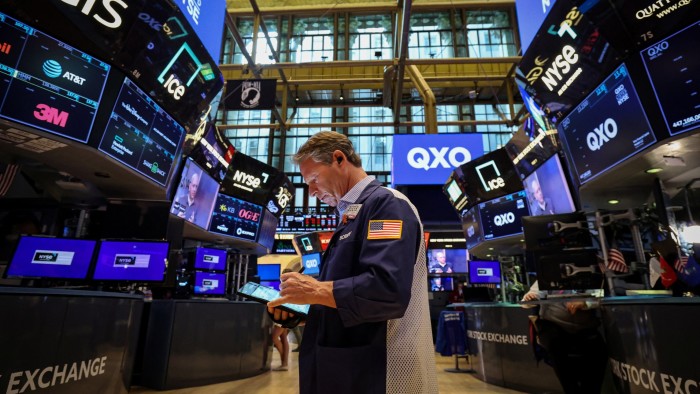Unlock the Editor’s Digest for free
Roula Khalaf, Editor of the FT, selects her favourite stories in this weekly newsletter.
Professional investors are slowly waking up to the realisation that, quite by accident, they have become enormously overexposed to the US, and they’re not sure of the way back.
For as long as anyone who manages money for a living has been in this game, US stocks have been a natural destination for foreign investors, whereas loading up on the UK, Europe, Japan or emerging markets has always been perceived as a bolder call.
“When you didn’t know where else to go, the US was the choice,” as Fabiana Fedeli, chief investment officer for equities at M&G Investments put it. “In the past, no one would lose their job for over-allocating to the US.”
For reasons almost too obvious to get in to, those days are over. Other countries have, over the years, conducted unorthodox experiments in the rule of law and monetary policy (Turkey) or trade and fiscal policy (UK), with damaging market consequences. But this time around, the US is playing fast and loose, and it unfortunately occupies a much larger slice of the average institutional investor’s portfolio.
As a result, the key conversation in asset management now is around the new “neutral” level. What is it? How much US exposure is too much?
The starting point is not great for those now worried about US political risk. Major global stocks indices for developed markets, which lots of investors either use as a benchmark or track directly using passive instruments, bung around 70 per cent of your money in to the US in line with the size of the underlying companies.
That’s fine as long as the US is stable, predictable, and spewing out superior returns, which it has done for years. It is less fine when the engine of those superior returns — the tech sector — is arguably the biggest long-term beneficiary of the globalisation that the country’s president is now working hard to dismantle. Competitors overseas are making some progress at catching up. Policy dysfunction and institutional erosion in the US are the icing on the cake.
Ironically, over the years, European investors have been particularly enthusiastic adherents to the American exceptionalism theme. Perhaps their proximity to stultifying European regulation has pushed them to the go-getting shores across the Atlantic. “If you have been beaten up 10 times [on Europe] you are not going to think it’s light at the end of the tunnel,” said Kokou Agbo Bloua, head of economics, cross-asset and quant research at Société Générale. “You are going to think it’s a train.”
Now, though, the mood has shifted, particularly in fact since last summer’s short, sharp markets wobble that highlighted concentrated US exposure. The French bank is sketching out what it’s calling the “Great Rotation” out of US assets, and how it might pan out in the coming years.
The early stages of this are happening already, and as Deutsche Bank’s George Saravelos puts it, it’s “not pretty” for the US. “The flow evidence so far points to an, at best, very rapid slowing in US capital inflows and, at worst, continued active disinvestment from US assets,” he said in a note this week. Foreign investors are on a “buyers’ strike”, he said, looking at flows in exchange traded funds.
So far, this is just the tip of the iceberg. But if 70 per cent is too much to park in the US, what is the right number?
Fedeli at M&G Investments says her clients in Europe and Asia are actively asking that very question, not in terms of whether they should reallocate, but how. US investors are much more “domestically focused”, she added. And in my experience, endlessly optimistic Americans generally argue that normal service in markets will resume shortly — I’m not convinced.
In theory, a better alignment to different countries’ contribution to global GDP could make sense. “To me that’s the end point,” Fedeli said. But that would involve cramming the US down to a 25 per cent allocation, maybe 30 if you strip back some of the Chinese slice to account for that market’s poor accessibility. “It’s unlikely to go to 30 per cent in my lifetime,” she said. I did not ask her age, and of course neither should you, but my grandma turned 102 this week and she’s in fine fettle, so it’s possible it will happen in my lifetime. But we digress.
The right US slice might settle around 55 per cent, as SocGen calculates that is around the share of global earnings that comes from the country — it really does punch above its weight. Maybe a little more, to account for the superior depth and liquidity of the US market.
Such a shift would not happen overnight, and no one expects it to come from a huge sell-off of US assets. As new money comes in to be invested, though, the rest of the world is likely to grab a much bigger slice.
Big institutional investors are not flinty fast-moving hedge funds or retail funds. They are vast supertankers that move slowly, and methodically, but make big waves. Tilting their balance towards Europe and Asia and away from more familiar ground in the US, even just a little, marks a huge re-engineering of global markets. For many, the US has become a riskier bet.
katie.martin@ft.com

